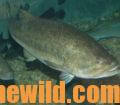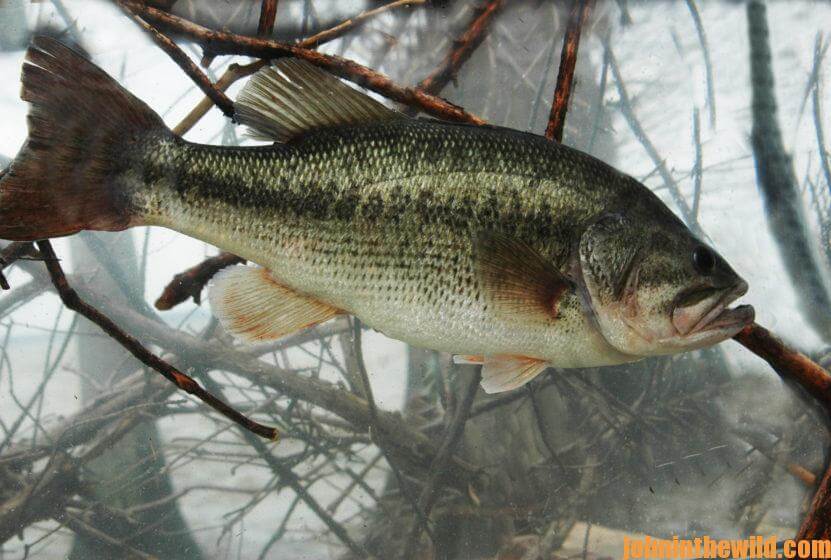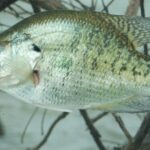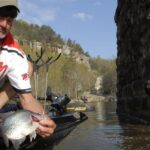Editor’s Note: Hunting season is not the time to be bass fishing, or at least that’s what most sportsmen once believed. However, in the last two decades, with the volume of information that has been unearthed about bass and bass angling, many fishermen have found that hunting season and the cold months of January and February are the most-productive times of the year to bass fish.
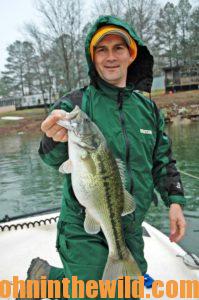 One of the places where anglers can discover schooling bass in the wintertime and catch them on the jigging spoon is on the edges of old creek channels where the timber has been standing before the lake’s been raised. Although bass will suspend above these submerged treetops, sometimes the fish will move down into the tops of the standing timber.
One of the places where anglers can discover schooling bass in the wintertime and catch them on the jigging spoon is on the edges of old creek channels where the timber has been standing before the lake’s been raised. Although bass will suspend above these submerged treetops, sometimes the fish will move down into the tops of the standing timber.
The first thing most fishermen consider when they see bass in submerged treetops is that if they drop their jigging spoons down into the tops, the spoons probably will get hung – making the anglers lose their baits. Or, they may worry that if they do get a bass on, they probably won’t be able to work the fish out of the top without breaking it off. However, both of these assumptions usually are wrong.
Because of the weight of the jigging spoon, if the hooks do become stuck in the underwater limbs, the weight of the plug will knock the hooks out of underwater wood by your simply jiggling the spoon up and down. If a bass takes a jigging spoon in heavy timber, it must grab the bottom end of the spoon where the hooks are to get hooked. Most of the time a bass will inhale the spoon, so that when the fish is hooked, there will be no hooks outside of its mouth to get caught in the timber. So, actually getting a bass out of a deep treetop is much easier on a jigging spoon than on a crankbait.
Often an angler keeps a jigging spoon tied onto one of his rods when wintertime bass fishing whether he’s vertical jigging, worming or cranking. Sometimes in the winter, especially if a warm day occurs, large schools of bass will start to come up and feed on the surface. Doubtless, you’ve seen before what’s appeared to be an  acre of largemouths busting the water and chasing shad. Most of the time usually the fish are about 30 yards further from the school than you can cast. However, because of the weight of the jigging spoon, and if you have this lure tied on to a flipping stick, you almost always can cast to the school and even past the school.
acre of largemouths busting the water and chasing shad. Most of the time usually the fish are about 30 yards further from the school than you can cast. However, because of the weight of the jigging spoon, and if you have this lure tied on to a flipping stick, you almost always can cast to the school and even past the school.
To get these fish on the surface to take the jigging spoon, the angler must retrieve the lure quickly before it can sink. Skipping the jigging spoon across the surface of the water works best for bass. Bass feeding on the surface will catch and attack the lure. If the fish don’t surface too far from the bait, a quick-handed angler may be able to take two or three fish out of the school before they go down. By continuing to cast to the area where the bass have been schooling and letting the jigging spoon sink, many times you can take one or two bass out of the school before they move – even if they’re not on the surface.
Although the jigging spoon primarily is fished vertically, the lure will take bass on the surface and in mid-water. But unlike crankbaits, buzzbaits and worms, the jigging spoon is not a “fish-anywhere, fish-anytime” lure. Rather it’s a situation bait. When the situation is right, the jigging spoon is the most-productive bait available to fish. The best situation for fishing a jigging spoon is wintertime vertical jigging and casting to schooling bass when they break the surface during the winter months.
To learn more about catching bass, check out John E. Phillips’ book, “Hot Weather Bass Tactics” at http://amzn.to/11HFpUc, available in Kindle version. 
Tomorrow: How to Fish Plastic Worms and Flutter Spoons and What Tackle Catches Wintertime Bass

